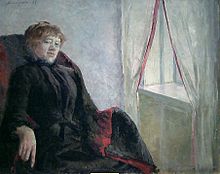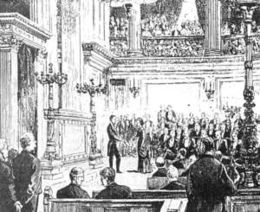Cecilie Thoresen
Ida Cecilie Thoresen Krog (born March 7, 1858 in Eidsvoll , Akershus province , † November 13, 1911 in Kristiania ) was a Norwegian suffragette . She gained fame primarily because she was the first woman in her country to take her Abitur in 1882 . She then enrolled at the university as Norway's first student.
Life
Family and first years
Cecilie Thoresen grew up with three brothers and a sister in the small town of Eidsvoll, where one of the most modern constitutions in Europe was adopted in 1814 . Her father from Telemark , Nils Windfeldt Thoresen, was a district doctor and a wealthy landowner, her mother, Marie Johanne Benneche, a well-read and linguistically gifted merchant's daughter from Kristiania (today Oslo). As a child, Cecilie Thoresen developed a great passion for skiing , took part in races and also gained experience in ski jumping , which was completely unusual for girls at the time .
She received private tuition, sometimes together with her brothers. As a young girl she began to take a lively interest in the progressive literature of her time. She read z. B. the lecture series The main currents of the literature of the nineteenth century (Hovedstrømninger i det 19. Aarhundredes Litteratur), in which its author, the Danish-Jewish scholar Georg Brandes , called for a modern literature beyond Romanticism and Biedermeier, the current “problems for debate “Should ask. Early familiar she was with the feminist views in John Stuart Mill's later publication The Subjection of Women (The Subjection of Women) - Brandes had translated into Danish, the book.
Middle school and high school
Her intellectual curiosity motivated her to work for the best possible education. Looking back, she said in an interview in 1907: "I was already twenty years old when I decided to graduate from high school in order to become something later." In 1879 she passed the exam at Nissens Girls School (Nissens Pikeskole) in Kristiania . Then she was supposed to "learn something decent " and began a course for office ladies at a business school . After she said she was "bored for eight days," she dropped out. She wrote a letter to her father telling him that she would like to take the examen artium , which was an entrance requirement for university studies and corresponded to the Abitur . Until then, however, young women were denied this educational path. Nevertheless, her father, who was close to the ruling conservatives and who subscribed to the bourgeois Morgenbladet , promised to support her. At that time, Cecilie Thoresen was enthusiastic about the ideas of the opposition politician Johan Sverdrup , who gathered critical officials and peasants around him and who significantly promoted the introduction of parliamentarism in Norway. Her father wrote to the responsible Ministry of Churches and Education, but received - dated December 24, 1880 - the answer that Cecilie could not be admitted to the Abitur examination.
Cecilie Thoresen then contacted the church minister, Jens Holmboe , who passed the ball on to the only university in the country in Kristiania at the time . There, the young woman's request was rejected by the responsible committee with only one vote against. Cecilie Thoresen did not give up and now sought the assistance of Hagbard Berner , a trained lawyer and Sverdrup collaborator, who was open to political reforms and who had co-founded the radical liberal daily Dagbladet in 1869 . Berner worked out a private bill that was discussed in the two chambers of the Storting , the Norwegian parliament, and initially met with opposition. The draft, it was said, was detrimental to society, which could only derive full benefit from the woman's work "if due consideration was given to her natural dispositions, her peculiar emotional life as well as her talents and preferences during her education and training." would. On June 15, 1882, despite such concerns, a large majority passed a new law that from then on enabled women to take the examen artium . Regardless, theology professor Fredrik Petersen continued to try to keep Cecilie Thoresen away from the exams. He pointed out that she had only graduated from high school with a limited amount of mathematics , as is also intended for girls; she was therefore not to be admitted to the examen artium . Cecilie Thoresen was allowed to take an additional exam, which she passed with success. The way to graduation was clear for her. Shortly afterwards, at the age of 24, she passed all exams with an overall grade of very good . Her best subjects were Old Norse , English, History, Oral Mathematics, and Science .
Education
On September 8, 1882 , Cecilie Thoresen enrolled in the ballroom of the college to study at Kristiania University. The contemporaries were aware of the historical significance of this act. All the major newspapers sent reporters to the university, and the then rector of the university, law professor Ludvig Aubert, gave a speech in which he praised the new opportunities offered by young women without, as he added, “their natural limitations to exceed ". Cecilie Thoresen also went abroad for a year to the University of Copenhagen , where she studied mathematics and natural sciences. Cecilie Thoresen did not complete her studies, however, because she married the lawyer Fredrik Arentz Krog, a brother of the women's rights activist Gina Krog , and gave birth to two sons and a daughter in quick succession. In an interview in 1907 she said: “I probably always intended to get married, but I was of the opinion that it should be possible to continue studying, even with small children. But that was not possible. My children were very busy when they were little. ”Cecilie Thoresen was also exposed to strong social pressures regarding the role of mother. Nevertheless, with her commitment, she enabled new generations of women to take up studies.
Commitment as a women's rights activist
On November 2, 1883, Cecile Thoresen was one of the co-founders of a private discussion club that bore the symbolic name Skuld - after a Norn in Norse mythology who embodied the future. She was also elected to the club's first board of directors. The 24 women, including some who were married to Sverdrup colleagues, met in turn in their apartments and gave each other lectures on "learned" and "profound" topics in order to train themselves as participants in the discussion. From this club, the Norsk Kvinnesaksforening (Norwegian Women's Rights Association) emerged in 1884 , the first chairman of which was a man, Hagbard Berner. Cecilie Thorsen's sister-in-law Gina Krog, who uncompromisingly advocated equal rights for women, was elected deputy chairwoman . In 1885 Cecilie Thoresen was one of the ten women who founded the Kvinnestemmerettsforeningen , an institution whose aim was to enforce women's suffrage in their country. She did not live to see the success of her work, however, because Norway was one of the first European countries to allow women to vote until 1913, two years after Cecilie Thorsenen's death. In 1904 she founded the Norske Kvinner Nasjonalråd (National Council of Norwegian Women), an umbrella organization of various women's groups, which joined the International Women's Council as the Norwegian section .
In her final years, Cecilie Thoresen suffered from endocarditis . She died in 1911 at the age of 53.
Afterlife

The 100th anniversary of Cecilie Thoresen's enrollment at Kristiania University was celebrated all over Norway with gala lectures, other events, the publication of articles and a book. In several Norwegian cities (e.g. in Oslo and Trondheim ) streets are named after Cecilie Thoresen today. In the Sophus Lie Auditorium of the University of Oslo, a bronze wall relief by the sculptor Kari Rolfsen commemorates her.
The eldest son of Cecilie Thoresen, Helge Krog , is one of the most famous Norwegian playwrights of the 20th century.
Individual evidence
- ↑ a b c d e f Aslaug Moksnes: Cecilie Thoresen Krog . In: Norsk biografisk leksikon .
- ^ Georg Brandes: The main currents of the literature of the nineteenth century . Translated and introduced by Adolf Strodtmann. Charlottenburg 1900, vol. 1, p. 6 .; see. on this: Uwe Englert: The "modern breakthrough". In: Bernd Henningsen (Ed.): Elective Affinities. Scandinavia and Germany 1800 to 1914. Berlin 1997, pp. 209–213.
- ↑ a b c d Clara Thue Ebbell: Kvindelige studenters jubilæumsskrift 1882–1907 . Kristiania 1907.
- ↑ Anna Caspari Agerholt: Den norske kvinnebevegelses history. Ny utgave. Oslo 1973, p. 59 f.
- ↑ Ubrukt materiale fra 1800-tallet , Kilden - Informasjonssenter for kjønnsforskning, accessed on March 4, 2013.
- ↑ Hans Try: To Kulturer, en stat: 1851-1884 (= Knut Mykland (Hrsg.): Norges historie. Vol. 11). Oslo 1995, p. 392.
- ↑ a b Åse Camilla Skaarer: Norsk Kvindesagsforening , stemmerett.no, accessed on March 3, 2013.
- ↑ Kirsti Strøm Bull: Kvinner på universitetet 100 år . Oslo 1984.
- ↑ Cecilie Thoresen - Universitetets første kvinnelige student , www.uio.no, accessed on March 3, 2013.
literature
- Aslaug Moksnes: Cecilie Thoresen Krog . In: Norsk biografisk leksikon . Retrieved January 1, 2015.
- Anna Caspari Agerholt: Den norske kvinnebevegelses historie. Ny utgave. Oslo 1973.
Web links
| personal data | |
|---|---|
| SURNAME | Thoresen, Cecilie |
| ALTERNATIVE NAMES | Thoresen Krog, Ida Cecilie |
| BRIEF DESCRIPTION | Norwegian suffragette, first student in Norway |
| DATE OF BIRTH | March 7, 1858 |
| PLACE OF BIRTH | Oathful |
| DATE OF DEATH | November 13, 1911 |
| Place of death | Kristiania |

